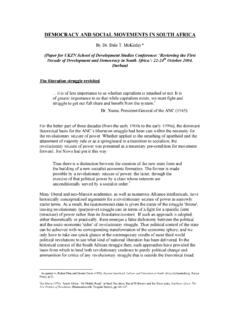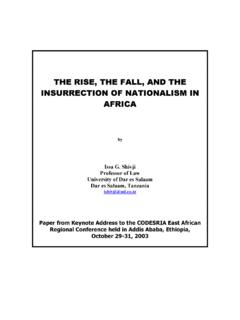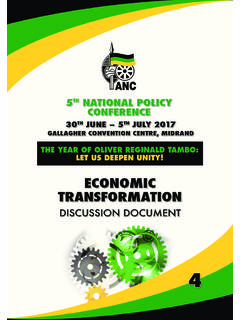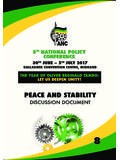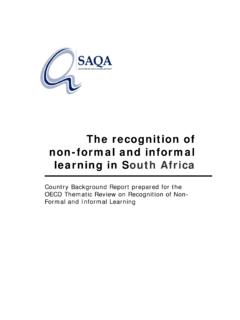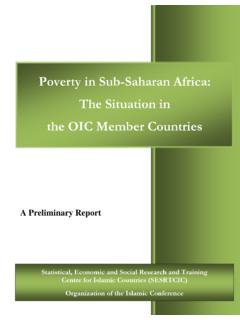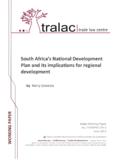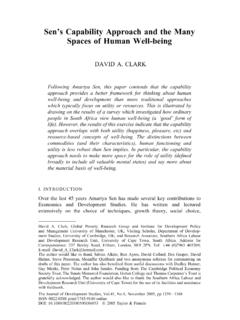Transcription of South African Poverty and Inequality Assessment …
1 South African Poverty and Inequality Assessment discussion Note (Draft for discussion only). Draft January 20161. Contents 1. Introduction and motivation 1. 2. Historical and socio-economic context 2. 3. Links to previous and existing work 6. 5. Data sources 7. 6. Outline of the report and its content 9. Part 1: The nature of the Poverty in South Africa 10. A. Methodology for measuring Poverty in South Africa 10. B. Poverty and Inequality trends 11. C. Profile of the poor 12. D. Challenges of income Inequality 12. E. Income mobility, chronic Poverty and economic vulnerability 13. F. Non-income dimension of Poverty 14. Part 2: Determinants and causes of Poverty and Inequality 15. Part 3: Challenges of Poverty reduction 16. A. High Inequality as an obstacle for the fast Poverty reduction 16. B. The labor market challenges 17. a. Analysis of labor market deficiencies focusing on SMEs and informal economy 17. b. Role of migration in the labor market 18. c. Declining employment in the mining sector 19.
2 D. Role of labor market institutions and minimum wage 19. C. Maximizing the return on social protection and delivering on the social wage 21. D. Improving the performance, access and returns to education 23. E. Health, HIV AIDS and non-communicable diseases 25. F. Economic geography of Poverty 25. G. Agriculture, food security and nutrition 26. Part 4: Reforming policies for alleviating Poverty 29. 7. Process 30. 8. Other timeline, team composition, budget 30. 9. References 31. 1. Prepared by Julian May, Victor Sulla and Precious Zikhali Draft for discussion only 1. 1. Introduction and motivation Reducing Poverty and Inequality has been the cornerstone of development policy in South Africa since the advent of democracy. Such goals gave impetus to the Reconstruction and Development Program (RDP), guiding government's policy framework in 1994; they are the inspiration behind the National Development Plan of 2012. The government's commitment to eliminate Poverty is also reflected in fiscal policy: the equitable share formula, which is used to determine transfers to the different spheres of government, contains a Poverty component as a redistributive measure.
3 South Africa has made significant strides towards enhancing the wellbeing of its citizens by reversing the adverse effects of apartheid and broadening opportunities for all. This has, however, been challenged by variable economic growth prospects which have specifically been quite modest in recent years. The relatively high and consistent growth experienced following the end of apartheid began to taper off when structural constraints and bottlenecks dampened growth; reaching a historical low in 2009 when the global financial crisis led to the country plunging into its first recession in 17 years. GDP growth rose to percent in 2011. Persistent structural weaknesses and new vulnerabilities such as those observed in the mining sector over the past two years, compromised the economy's ability to sustain such growth, so that the growth reading was a paltry percent in 2013, percent in 2014, and the economy was projected to grow by only percent in 2015. The economic gains made since the end of apartheid have enabled the government to use a variety of mechanisms through which it aims to reduce Poverty and Inequality .
4 These are reflected in what is broadly termed the social wage which basically refers to the redistributive elements of the government budget. Notable gains have been made as a result of these interventions: these measures have been argued to be the drivers of the observed reduction in Poverty in South Africa, with recent statistics showing that the Poverty headcount rate reduced significantly between 2006 and 2011. However and despite its upper middle income status, the country still faces persistent socio-economic challenges which the South African government describes as its triple challenge ( Poverty , unemployment and Inequality ), a triple epidemic (malnutrition, HIV/AIDS, tuberculosis), and a triple burden of malnutrition (under- nutrition, hidden hunger and over-nutrition). The persistence of these challenges, 22 years after the advent of democracy, calls for a comprehensive Assessment of trends, dynamics, policy, impact and monitoring. This is especially pertinent given that the last comprehensive national Poverty and Inequality Assessment was published in 1998 and commissioned by the Government of South Africa with assistance from the UK Department for International Development, UNDP, World Bank and the Dutch Government.
5 The proposed Poverty and Inequality Assessment will document South Africa's progress in reducing Poverty from 1994 to 2015. It aims to contribute towards South Africa's realization of its national targets of eliminating extreme Poverty and reducing Inequality . This is important given that although South Africa has achieved significant transformation in terms of improving access to services, education, health care and economic opportunities, the reduction of the prevalence and depth of Poverty has met the aspirations of neither the government nor South Africans. This is despite the recognized success of fiscal policies for redistribution through a social wage of free basic services and access to facilities, expenditure on health and education that exceeds that of many similar countries, and the provision of comprehensive social protection. The co-existence of apparently sound policy, significant government expenditure but slender returns in terms of impact suggests the potential that greater efficiencies can be achieved.
6 The objectives of the proposed Poverty and Inequality Assessment are twofold: First, the proposed report aims to contribute to an enhanced understanding of how the government can achieve greater efficiencies in its efforts to tackle the problem of Draft for discussion only 1. Poverty and Inequality . This way, the report will contribute to policy dialogues towards the attainment of the NDP vision of eliminating Poverty and reducing Inequality . The Assessment will do this not only by providing Poverty trends but also by examining the drivers of changes in Poverty and Inequality since the end of apartheid in 1994; investigating the extent to which economic growth has been pro-poor; and dissecting and proposing possible solutions to the challenges that South Africa faces in the fight against Poverty and Inequality . In addition, a forward looking forecasting exercise will be undertaken and is envisaged to inform policy discussions, formulation and planning. Second, in April 2013, the World Bank set two goals to end extreme Poverty and promote shared prosperity (World Bank, 2013).
7 This implies a focus not only on the pace of economic growth but also on its pattern. Promotion of shared prosperity means working towards increasing the incomes and welfare of the poor. For the World Bank, monitoring progress made towards shared prosperity implies measuring and tracking the income or consumption growth amongst a country's bottom 40 percent. It is an indicator of economic growth with equity and inclusion and can thus be used to measure the impact of policies targeted at reducing Poverty and Inequality . Growth is said to lack inclusiveness if the income or expenditure growth of the bottom 40 percent is consistently lower than the average income or consumption growth of the total population. The objective to foster income growth of the bottom 40 percent of the population includes most of those categorized by two of the national Poverty lines used in South Africa even though levels of extreme Poverty as defined by the World Bank are comparatively low. The proposed Assessment will both guide the Bank's future transformational engagement with South Africa and provide a peer reviewed and independent Assessment of the policy/implementation nexus that can be used by the South African government and civil society.
8 Overall, the Assessment will identify key knowledge and policy gaps and provide new analysis that addresses selected gaps or complements existing work on these topics. It will build on substantial existing work and knowledge base that includes large sample surveys, panel data, detailed evaluations and impact assessments, as well as qualitative studies undertaken by South African universities. Data from the recently completed Living Conditions Survey 2015 by Statistics South Africa create an opportunity for providing an up to date picture on Poverty and Inequality in the country. Data from the four waves of the National Income Dynamics Study (NIDS) permit the analysis of Poverty dynamics. The Assessment will feed into national planning and Poverty monitoring activities. This discussion paper outlines the context for the Assessment , provides suggestions for the content of the report, the process to be followed in its preparation, and identifies existing key studies and possible data sources.
9 2. Historical and socio-economic context The specificity of the South Africa situation remains relevant after more than twenty years of democracy. The four decades of apartheid legislation built on a century of the earlier policies of the Colonial and Union government directed at the extraction of cheap labor and racially based differentiation. To achieve this goal, and to contain mounting resistance to the apartheid government, a range of institutions and legislation were introduced, many of which regulated the livelihoods available to the African population. Wilson and Ramphele (1989:204, 230) conclude that such policies of deliberate impoverishment distinguished the experience and dynamics of Poverty in South Africa and constituted an assault upon the poor . As such, apartheid, and the legislation and institutions through which this ideology was implemented, operated to produce structures of privilege and extreme Inequality that still slow progress towards the reduction of Poverty .
10 The concept that separate land areas should be set aside for Africans in South Africa predates the founding of a modern economy in South Africa and continues to shape the geography of Poverty in South Africa. This evolved from the policies followed by early white Draft for discussion only 2. settler governments who set aside land initially known as native reserves' and later as Homelands. This was institutionally formalized by the Union Government in 1913 with the passing of the Land Act. At that time, it was never seriously envisaged that the African population should remain limited to the land that had been set aside for their use. However, with the victory of the National Party in 1948, the segregationist views of this party were translated into the policy of apartheid and a wide range of legislation was introduced between 1949 and 1959 to balkanize South Africa into a number of ethnic based territories or Homelands, each with some measure of nominal political independence.

